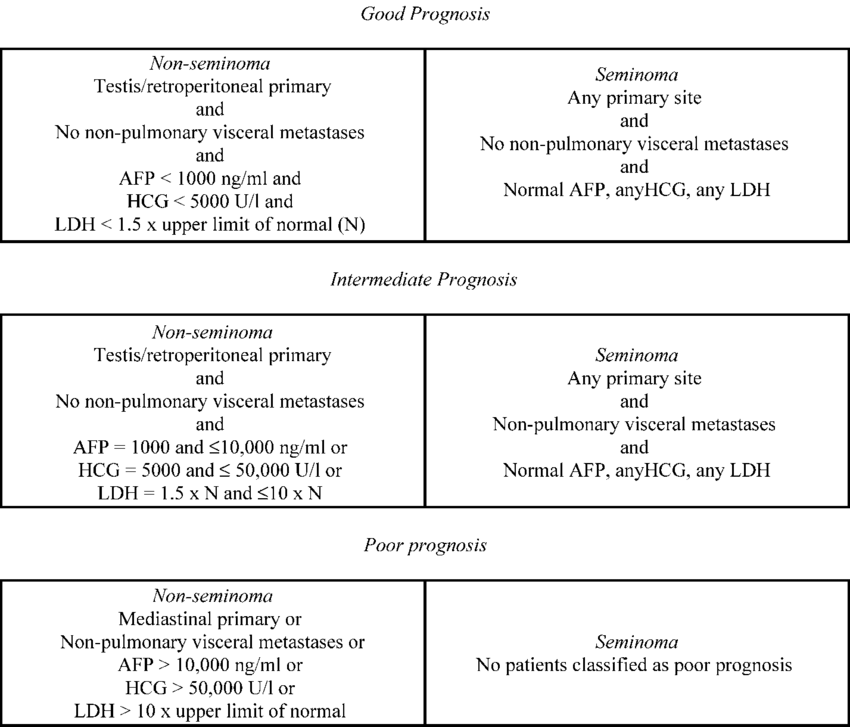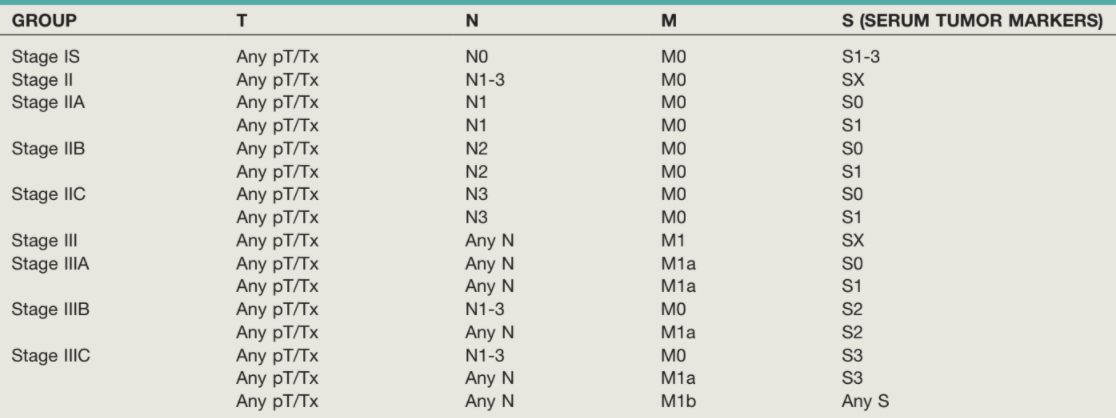Testis Cancer: Initial Evaluation and Orchiectomy
Background
Epidemiology
- Prevalence: rare, only 8K-9K cases per year
- Age: most common cancer in 20-40yo men
- Stage at presentation: majority (~2/3) present with Stage I, < 15% present with Stage III disease
- Bilateral disease: 2%, usually metachronous within 5yrs of initial presentation
- Extragonadal primary: seen in 5%, usually in retroperitoneum or mediastinum
Risk factors
- Intratubular germ cell neoplasia (ITGCN): 50% testis cancer risk in 5yrs
- Cryptorchidism: 4-6x, 2-3x if pexied pre-puberty, 1.74x risk in contralateral testis
- Family hx: increased risk if first-degree relative with testis cancer
- Personal hx: 12x compared to general population, but 15yr incidence is only 2% (because testis cancer is overall rare)
- Other potential risks: HIV, gonadal dysgenesis with Y chromosome, infertility (2-3x risk), Klinefelter syndrome (increased extragonadal risk), CHEK2 mutation (4x risk)
- Non-risk factors: atrophy, trauma (increases chances of diagnosis), microlithiasis (incidental finding only)
Types
- Germ cell tumors: seminoma (~55%) vs non-seminoma germ cell tumor (NSGCT, ~45%)
- NSGCT: includes choriocarcinoma, yolk sac, embryonal, and teratoma
- Seminoma: doesn't make AFP, XRT-sensitive
- Choriocarcinoma: can spread hematogenously, cause hemorrhagic metastases
- Teratoma: chemo-resistant, can rapidly grow, can transform into somatic malignancies (sarcoma, etc), no difference in adults between immature and mature
- Embryonal carcinoma: presence in orchiectomy specimen increases risk for occult metastases
- Yolk sac tumor: more common in mediastinal and pediatric tumors, almost always make AFP, do not make HCG
Presentation and Workup
Symptoms/Signs
- Symptoms: painless swelling, pain (10% from hemorrhage/infarction), chest/back/abdominal pain, cough/dyspnea
- Signs: hard/enlarged testicle, abdominal mass, subclavicular lymphadenopathy, gynecomastia
Imaging workup
- Scrotal US: solid testis mass is testis cancer until proven otherwise
- Staging: obtain CT C/A/P to assess for retroperitoneal and other lymphadenopathy, CT misses 30% metastatic disease
- Chest imaging: can get CXR instead of CT chest if low risk for thoracic metastases
- Brain imaging: consider if HCG > 5K, AFP > 10K, neurologic symptoms, extensive lung mets, or non-pulmonary visceral mets
- Bone imaging: only if specific clinical indication
- Observation: if mass < 1cm and normal STMs, can consider repeating labs and US in 6-8 weeks (may be benign lesion), consider MRI for inconclusive lesions
Serum Tumor Markers (STMs)y
- LDH: nonspecific marker produced by 20% GCT, magnitude correlates w/ disease bulk, also seen with lymphoma and infection/inflammation
- AFP: produced by yolk sac and embryonal (elevated AFP = NSGCT), never produced by pure choriocarcinoma or seminoma, also seen with infants < 1yo, lung, biliary, stomach, panc, liver cancer, liver disease, ataxia telangiectasia, and tyrosinemia
- bHCG: produced by 10-30% NSGCT (always if choriocarcinoma present) and 10-15% seminomas, also seen with liver, panc, stomach, biliary, lung, breast, kidney, bladder cancer, marijuana use, hyperthyroid hypogonadism (cross-reactive with LH)
- Do not treat solely based on elevated LDH (non-specific) or elevated AFP < 25 (can be normal)
- Half-Life: AFP (5-7 days), LDH (3-5 days), bHCG (24-36 hours)
- S0: normal STMs
- S1: LDH < 1.5x normal, AFP < 1K, bHCG < 5K
- S2: LDH 1.5-10x normal, AFP 1-10K, bHCG 5-50K
- S3: LDH > 10x normal, AFP > 10K, bHCG > 50K
Sperm Banking
- Discuss sperm banking prior to orchiectomy (standard of care)
- Pre-orchiectomy findings: 50% have abnormal semen parameters and 10% have azoospermia at presentation
- Cisplatin chemotherapy: causes azoospermia, 50% recovery by 2yrs, 80% by 5yrs
- XRT: > 6 Gy causes azoospermia, oligospermia is dose dependent below 6 Gy
- RPLND: 80% have permanent ejaculatory dysfunction, reduced to 10% w/ nerve-sparing techniques
Orchiectomy
Tips for Minimizing Cancer Recurrence
- Approach: perform orchiectomy via inguinal (not scrotal) incision (standard of care), removes spermatic cord and does not alter lymphatic drainage
- Local recurrence rates 2.5% with scrotal violation (vs 0% via inguinal approach)
- If able, place testis prosthesis
- Contralateral testis biopsy: consider if atrophic testis, history cryptorchidism, or younger than 40yrs (36% risk ITGCN vs baseline 5-9% ITGCN in contralateral testis)
Testis-Sparing Surgery
- Indications: mass < 2-3cm, equivocal US findings, negative STM, solitary testis, and/or b/l tumors
- Obtain biopsies from normal adjacent tissue (look for ITGCN)
- Increased recurrence risk overall, especially local recurrence (11% vs 0%)
- If ITGCN present, offer XRT or orchiectomy due to higher risk of recurrence
- Risks: need for intraoperative orchiectomy, ipsilateral atrophy (3%), hypogonadism (7%)
Scrotal violation management
- Trans-scrotal biopsy and orchiectomy should not be performed
- Local recurrence risk: increases to 2.5% from 0%
- pT4 suspected: excise portion of scrotum en bloc during inguinal orchiectomy
- Scar excision after scrotal orchiectomy: 9% had residual disease
- Surveillance: perform groin exams, check inguinal/pelvic nodes on imaging
References
- AUA Core Curriculum
- Calaway, Adam C., et al. "Percentage of teratoma in orchiectomy and risk of retroperitoneal teratoma at the time of postchemotherapy retroperitoneal lymph node dissection in germ cell tumors." The Journal of Urology 206.6 (2021): 1430-1437.
- Stephenson, A. and T. Gilligan. "Neoplasms of the Testis." Campbell-Walsh Urology 12 (2020).
- Stephenson, Andrew, et al. "Diagnosis and treatment of early stage testicular cancer: AUA guideline." The Journal of urology 202.2 (2019): 272-281.
- Wieder JA: Pocket Guide to Urology. Sixth Edition. J.Wieder Medical: Oakland, CA, 2021.
- Wilkinson PM, Read G. International Germ Cell Consensus Classification: a prognostic factor-based staging system for metastatic germ cell cancers. International Germ Cell Cancer Collaborative Group. J Clin Oncol. 1997;15:594-603.



